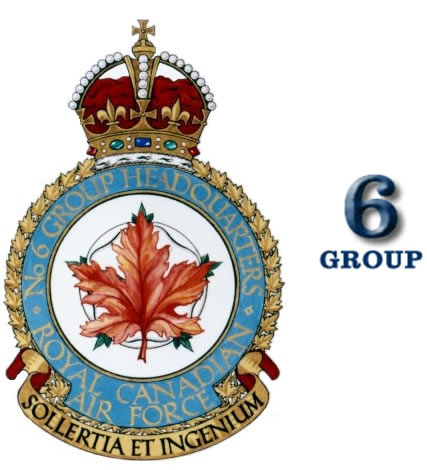433 Squadron (RCAF) 6 Group Skipton-on-Swale, Yorkshire, England
Previous | Home | Next

Source: Bomber Group 6 image from http://www.rcaf.com/6group
The Group badge is a Maple Leaf superimposed on a York Rose, symbolizing the close relationship that the RCAF had to Yorkshire.
The Motto is "Initiative and Skill"
A Group unique in the annals of Bomber Command by virtue of its overseas nationality was No. 6 (Royal Canadian Air Force) Bomber Group - or the Canadian Bomber Group as it was sometimes known - which formed in and operated from Yorkshire and neighbouring territory during the second half of the war. (Although 6 Group was Canadian, it was part of the RAF controlled Bomber Command.) From relatively small beginnings, No. 6 Group grew to 14 heavy bomber squadrons and compiled, in the greatest aerial offensive in history, a battle record second to none.
Some idea of No. 6 Group's battle record can be gained from the fact that in 1944 it flew 25,353 operational sorties and dropped 86,503 tons of bombs and mines with the lowest loss percentage of four-engined aircraft in the whole of Bomber Command. Following D-Day, during one single month (August), Halifaxes and Lancasters of the Group flew 3,740 operational sorties and dropped 13,274 tons of bombs - more than the total dropped on London by the Luftwaffe during the entire war. Furthermore, aircraft serviceability was maintained at an average of more than 80 per cent. For two attacks on Duisburg made within a period of 16 hours on 14th October 1944, No. 6 Group supplied 501 aircraft - 25 per cent of the total force - in the greatest day's effort of its existence. Losses were infinitesimal, only five aircraft - four of them in the daylight attack. The Group's heaviest attack of the war was against Dortmund on the night of 6th/7th October 1944, when 293 Lancasters and Halifaxes took off from their Yorkshire and near-Yorkshire bases: 273 bombed the primary target, three attacked an alternative, two failed to return, and the remainder were for various reasons unable to drop their bombs.
The cost of No. 6 Group, with the single exception of the pay and allowances of attached RAF and other non-RCAF personnel, was borne by the Canadian Government and the full upkeep of the operational squadrons, including the cost of fuel and ammunition, was defrayed from Canadian taxes and domestic loans.
At the war's end the RCAF had 11 bomber stations in England. Seven of these were operational stations, controlled by No. 6 Group, and four were bomber training units officially controlled by the RAF Training Group, but having a long association with the Canadian Group. All of these stations were in - or just beyond - the Vale of York in the area north of Harrogate, the famous spa, and the ancient city of York. Group headquarters were in the castle at Allerton Park- immortalised as "Castle Dismal" by No. 6 Group's public relations officer - the home of Lord Mowbray and situated east of Knaresborough.
No. 6 (RCAF) Bomber Group officially assumed operational status at 0001 hours on 1st January 1943. During the next three days the RAF handed over to the Group six stations with the RCAF squadrons established thereon. These were Leeming (Nos. 408 and 424 Squadrons), Middleton St. George (Nos. 419 and 420 Squadrons), Dishforth (Nos. 425 and 426 Squadrons), Croft (No. 427 Squadron), Dalton (No. 428 Squadron) and, lastly, Skipton-on-Swale, which was then still under construction. The Group was also given control of No. 405 Squadron, then serving with Coastal Command (and later transferred to No. 8 (PFF) Group), and No. 1659 HCU with other specialised formations. With the exception of Nos. 405, 408 and 419 Squadrons, which had Halifax IIs or Vs, all the aforementioned squadrons were then flying Wellingtons. (In total 15 Squadrons, all in the 400 series would serve in 6 Group.)
Ready for operations, No. 6 Group flew its first mission on the night of 3rd/4th January, 1943, when six Wellingtons from No. 427 Squadron were sent to lay mines off the Frisian Isles. From that start the Canadian squadrons were active almost right up to VE Day - until their final mission against Wangerooge on 25th April 1945.
As the Group grew other stations and squadrons were added. RAF station Wombleton was turned over to the Canadians while under construction, and was completed by 20th October, to round out the stations of the training base. No. 429 Squadron joined the Group when East Moor station was taken over from the RAF on 1st April. On 18th June 1943, the permanent station of Linton-on-Ouse became Canadian, and with it the Tholthorpe station, then under construction. When Tholthorpe was ready for operations No. 62 (Beaver) Base was formed. The Canadian Group then had under its control the full complement of stations for wartime organisation. On 1st May 1944, Nos. 63 and 64 Bases were created and the only major change that followed was the transfer of the training base to RAF control in November 1944.